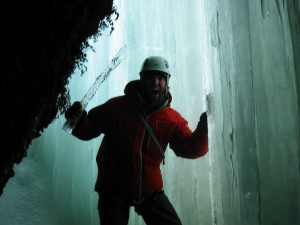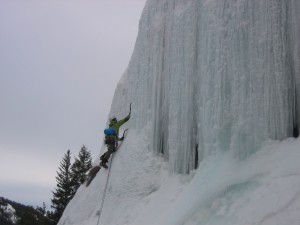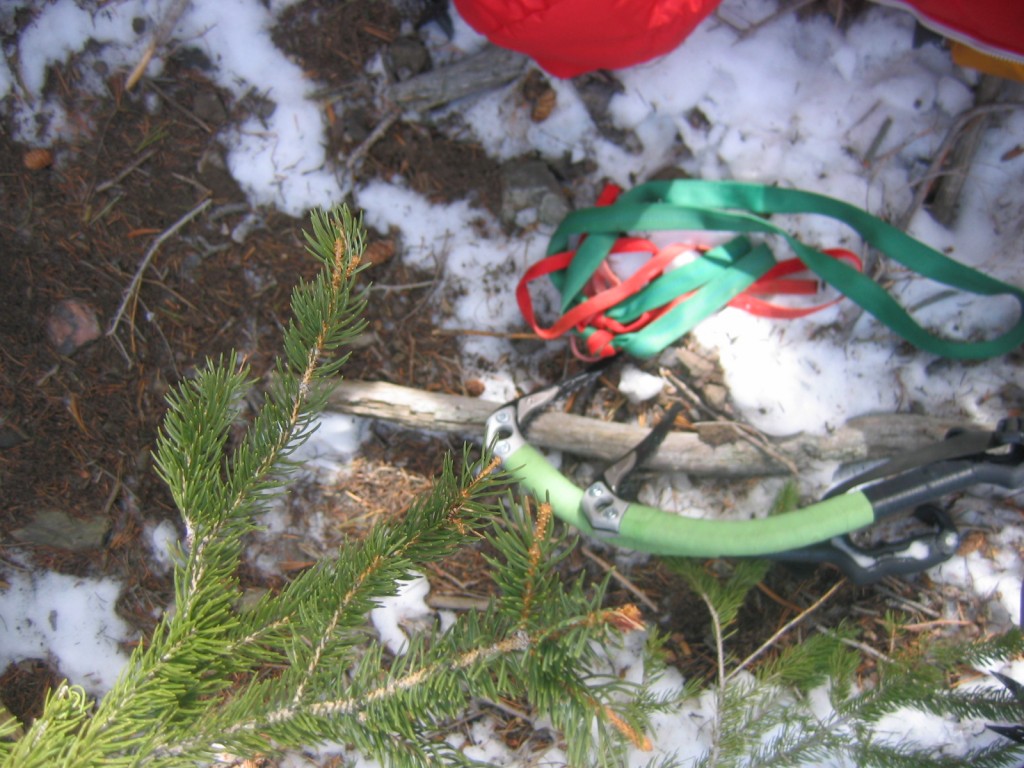
Hyalite in the morning.
Climbers spend a lot of time, energy, and money in the effort to keep themselves safe. A full rack of gear costs a small fortune, and the ability to use that gear efficiently and effectively takes years of experience. It’s no wonder there are literally volumes written on the subject.
A good belay anchor is a thing of beauty – equal parts gear, applied physics, and creative use of space – and, in this case, beauty often translates to safety. When you know those three large cams are equalized, backed-up, and bomber, it’s easy to relax and lean out over the five hundred feet of rock and air beneath you and focus on the task at hand.
Of course, the same things that make the belay so comfortable can make getting down a much more stressful situation. A pretty basic rock belay set-up will consist of three cams ($225), three wire-gate ‘biners ($25), two big lockers ($30), and twenty feet of 7mm cord ($8). That’s almost $300 worth of piece of mind at each belay. On the way up, it’s no big deal; the second climber just breaks it all down and hauls it up to the next belay or the top of the climb, whichever comes first. Getting back down to the ground, however, may be a little more tricky. If you can walk off, problem solved – just throw it all on the gear sling and hike it home. If the route requires a rappel, though, the game gets more serious since leaving all of that gear at each rap station isn’t really an option.

I can haz yetteh food?
Rappelling is often cited as the single most dangerous common climbing practice. This is so because it’s really the only time you’re relying fully on gear. If I’m leading an ice pitch and, in some tragic combination of poor aim and poor luck, I happen to sever my rope with a crampon point, I have a few options: if I’m not too far off the deck, I can just carefully climb back down; if I’m farther up, I can take a deep breath, center myself, and solo it out to the top; or I can plug in a screw or two, attach myself to the ice, and wait for my partner to figure out how to get me a rope. Obviously, this is not a good situation, but it is salvageable (for the record, this is just one of several reasons I prefer to climb ice on half and twin ropes, but therein lies another post altogether).

Leaving the deck on the first pitch of "The Dribbles" (WI 4) -- Hyalite Canyon
When I’m on rappel, though, I’m completely committed to the rope and whatever’s above it to keep me safe all the way down; I trust the rope, and I trust the harness/locker/belay device combo that attaches me to the rope – that leaves the attachment to the wall as the most likely weak link.
At popular rock climbing areas, rappel rings have often been drilled into the rock to safely facilitate this process. This is less likely in the mountains where trees tend to be the standard for rap anchors. Theoretically, you could just wrap the rope around the tree and rappel off, but that tends to accelerate the wear on both rope and tree and increases the likelihood that your rope will get stuck on the way down.
The usual response to that problem is to thread nylon webbing or cord through cheap metal rings and tie all of that around the tree. A few slings and a couple of rings around a BFT (“big” and “tree” are two of those words) will more than suffice as a safe and inexpensive rappel anchor. The climber need only make sure the slings are in good shape before leaning back and floating to the ground.

These are some old slings we cut off a rap tree. Climbing anchors are generally good to go, but they don't last forever. Be aware and be vigilant. If something looks suspect, back it up. Check out the Access Fund, the Anchor Replacement Initiative, or your local climbing organization if you're interested in the process.
Now, that was a long lead-in just to mention what Jason and I have been up to for the past week: climbing a lot of the more popular routes in Hyalite and replacing the worn rappel slings with brand new cord. We figured it would be a great way to give a little bit back to the Canyon. Certainly this is not a selfless pastime (our own safety will clearly benefit from the efforts), but it does make me feel a little more connected to the place – like I’m a part of the solution and not just the problem.

